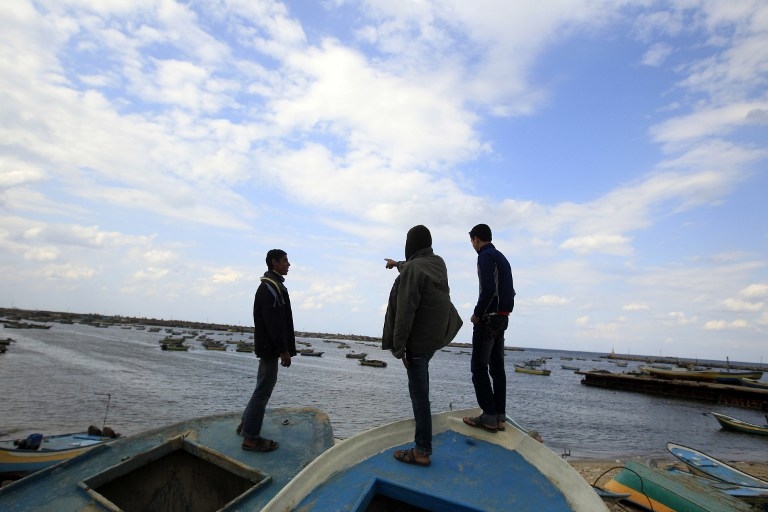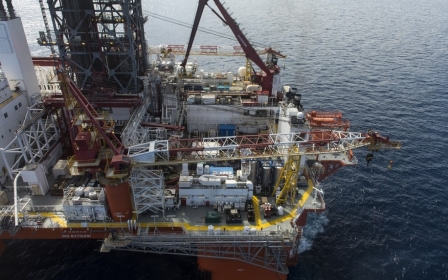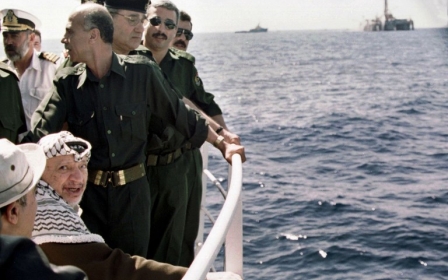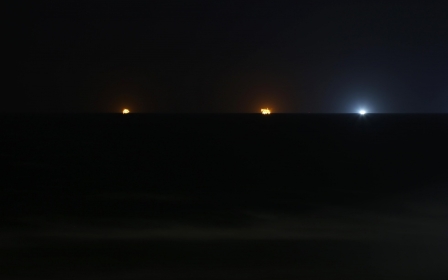TIMELINE: Why hasn't Gaza Marine produced gas?

1999
- British Gas Group discovers Gaza Marine (17 to 21 nautical miles from Gazan coast)
- Israeli companies in Yam Thetis consortium (Noble Energy and Delek Group) makes first gas discovery
November - 25-year contract for gas exploration and development of Gaza Marine signed between BG Group, the Palestinian-owned Consolidated Construction Company, and the Palestinian Investment Fund (PIF); Nabil Shaath, then the PA's Minister of Planning and International Cooperation, tells Palestinian radio: “Under the Gaza-Jericho agreement, the Israelis acknowledged our right to 20 miles (32 km) into the sea as an economic sovereignty area, including its potential resources, such as oil and gas."
2000
– BG Group drills two wells, does feasibility studies on Gaza Marine with good results
– First test drill on Israeli gas field Noa (estimated to have 0.04 tcf), adjacent to Gaza Marine; Mari-B, another field (estimated to have 1.5 tcf) discovered
Summer - Launch of Israeli, PA and BG Group negotiations within the Oslo narrative of economic cooperation
June – BG Group proposes to supply gas from Egypt, Gaza and Israel (fields off Ashkelon) to Israel Electric Corporation
July – Israeli PM Ehud Barak grants BG Group authorisation to secure first well in Gaza Marine, called Marine-1
-PA approves BG Group development plan including construction of a pipeline linking gas fields in sea to Gaza costing $150 mn
27 September – PA President and Chairman of the Palestinian Liberation Organisation Yasir Arafat lights first flame at Gaza Marine rig
28 September – Launch of Second Intifada
November – BG begins drilling second well in Gaza Marine (Marine-2)
2001
6 February – Ariel Sharon elected; vetos any Israeli purchase of Palestinian gas
2002
– BG Group conducts second feasibility study on Gaza gas (first is done in 2000). Cost of both is $100 mn (Kattan)
– Bertini Commitment reduces Oslo-agreed 20 nautical miles (37 nautical km) off Gaza for Palestinians to 12 nautical miles (22 nautical km)
May – Sharon lifts his veto, reportedly at urging of then UK-Prime Minister Tony Blair
2003
Summer – Sharon reverses his decision, claims money Israelis would pay to PA for gas could support terrorism, despite Israeli announcement that gas revenues to Palestinians would be transferred to a special account used for international aid and tax clearance revenues, according to Anais Antreasyan's 2012 paper on gas finds in the Eastern Mediterranean
2004
11 November – Arafat dies
2005
January – Mahmoud Abbas elected, sworn in as leader of Palestinian Authority
May – Israel and Egyptian company EMG sign $2.5 bn gas deal. Egyptian gas to be supplied to Israel for 15 years gas deal
September – Israel’s redeployment of Gaza
2006
- UK officials try, at some point during the year, to persuade Israel to return to the negotiation table with BG Group
January – Hamas election; nautical miles reduced down from 12 (19 nautical km) - from 2002 Bertini Commitment - to six (10 nautical km)
- Ehud Olmert replaces Sharon; reportedly has better relations with Blair
12 July – 14 August – Israel-Hezbollah war
2007
29 April – Israeli cabinet approves Olmert’s proposal for new discussions with BG Group
May – Terms of BG Group-Israeli purchase are revealed (Israel would purchase .05 tcf of Pal gas for $4 bn annually starting in 2009); Abbas and Israeli government secretly agree that PA share of revenues to be transferred through an international account inaccessible to the official PA govt dominated at that time by Hamas after the Jan 2006 elections. Gas to be piped to Ashkleon for liqurefaction in Israel, then supplied to Israeli market and cover limited Gaza needs.
14 June – Hamas seizes Gaza Strip – start of West Bank-Gaza split. Gaza government says it will change the terms of the contract (at that point, Pal share is 10 percent). But talks still continue between PA and Israel bypassing Hamas.
October – Then Israeli Deputy Prime Minister Moshe Yaalon advises Israelis not to conclude agreement with BG Group
20 December – BG Group announces end of negotiations with Israel because of "insurmountable disagreements"
2008
14 January – BG Group closes offices in Israel; keeps offices open in Ramallah and retains concession for the gas fields
February – Egypt becomes Israel’s main gas supplier
May - Group of Egyptian opposition MPs and activists launch campaign against Egypt gas deal with Israel; Israeli officials concerned, believe country should find alternative gas supplier
27 December – Gaza War starts; nautical miles assessible to Palestinians off Gaza reduced to 3 (5.5 km) from 6 (11 km)
2009
-Tamar gas field (estimated to have 10 tcf) discovered; situated 52 miles (83 kilometres) off Haifa; drilled by Noble energy and partners
18 January - Gaza War ends
March – Noble Energy discovers Dalit gas field (estimated to have 0.5 tcf), 27.3 miles off Israeli coast
2010
– Israel's largest gas field so far, Leviathan, discovered 81 miles (130 km) off Haifa
2011
January – Israeli Prime Minister Benjamin Netanyahu and Abbas open discussion again of possible gas contract after Egypt cuts volume of gas being sold to Israel during uprisings
4 February – Netanyahu announces, with Quartet Representative Tony Blair at his side, that time has come to develop Palestinian gas: “ . . . the revenues from the Palestinian fields go to the Palestinian Authority and the revenues from the Israeli field go to the Israeli government and I think this is good for stability, good for prosperity and good for peace.”
11 February – Egyptian President Hosni Mubarak resigns
May – Cairo says it will halt Israeli gas supply if higher price isn’t negotiated
November - Dolphin gas field discovered; estimated to hold 0.08 tcf
2012
February - Delek reports "strong signs" of gas at Tanin gas field, estimated to have 1.2 tcf
April – Egypt announces it will halt gas exports to Israel
June – Former Egyptian Oil Minister Sameh Fahmy sentenced in Egyptian court for selling underpriced Egyptian gas to Israel
August - Shimshon gas field discovered; estimated early on to have around 2.3 tcf, later thought to have 0.3 tcf
September – New round of PA-Israeli negotiations on gas begin; Hamas reiterates its rejection of any agreement without its participation: "We do not recognise any agreement reached by the Palestinian Authority regarding the gas fields off Gaza's shores, and the government in Gaza should be consulted over any agreement of this kind," said Hamas spokesman Sami Abu Zuhri. Talks end without progress
2013
30 March – Tamar field production begins; gas piped to Israeli Electric Company power plants in Ashdod
2014
January – Palestine Power Generation Company (PPGC) becomes first customer of largest Israeli gas field, Leviathan, signing letter of intent to pay $1.2 bn for 20 years' worth of suppply. Announcement that gas will be used at new power plant to be built near Jenin
February - Noble Energy signs $771 mn deal with Amman-based Arab Potash Company and affiliate Jordan Bromine to supply gas from Tamar for 15 years. US State Department mediates talks that lead to deal
May - Karish gas field is discovered; estimated to have 1.8 tcf
8 July - 26 August - Gaza war
September - Jordanian goverment signs letter of intent with Noble Energy for 15 years supply of Israeli gas, valued at between $14-$15bn.
10 December - Majority of Jordanian MPs vote against government deal with Noble Energy. Vote is non-binding, allowing government to move forward with deal if it wants.
23 December - Israel's Antitrust Authority head suggests he will break Noble Energy and Delek Group's ownership of Leviathan, throwing deals with Jordan and PPGC into question.
2015
March - PPGC calls off Israeli gas deal
Middle East Eye propose une couverture et une analyse indépendantes et incomparables du Moyen-Orient, de l’Afrique du Nord et d’autres régions du monde. Pour en savoir plus sur la reprise de ce contenu et les frais qui s’appliquent, veuillez remplir ce formulaire [en anglais]. Pour en savoir plus sur MEE, cliquez ici [en anglais].




